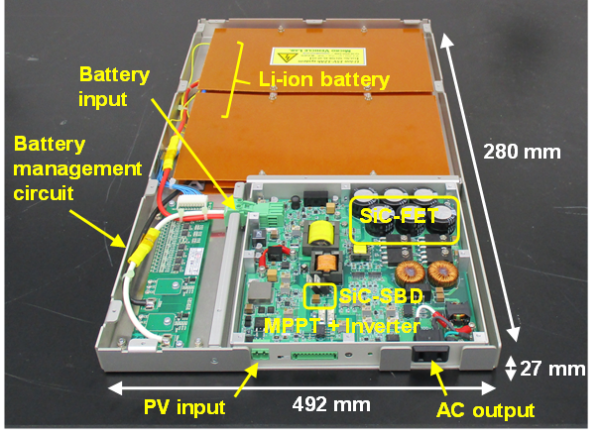Scientists from Japan’s University of Shiga Prefecture are investigating the potential of silicon carbide (SiC) inverters for sub-kilowatt level mobile PV applications.
The researchers said they developed a 150 W, lightweight SiC inverter equipped with a maximum power point tracking (MPPT) circuit and a 15 V lithium-ion laminate. The device was applied to a compact PV power system relying on flexible, lightweight, spherical crystalline silicon cells. The MPPT charge controller, battery and DC-AC converter consisted of four SiC metal-oxide-semiconductor field-effect transistors embedded in a battery-converter unit.
Small size, high efficiency
The system, which had an output power setting of 150 W, weighed 5.69kg, of which 2.13kg came from the 1,020x690x5mm solar cell strings, 2.77kg from the 492x280x27mm battery and only 790g from the 180x175x25mm inverter.
“The thinness of these cells ([less than] 10 mm) realized a thin-type power conversion apparatus in which the PV inverter module and battery module were mounted in the same housing,” the researchers wrote in the paper Dependence of electric power flow on solar radiation power in compact photovoltaic system containing SiC-based inverter with spherical Si solar cells, published in Heliyon and on the ScienceDirect website.
The scientists said the mini inverter showed efficiencies 3% higher than those of ordinary inverters of the same size. The improved performance, they said, was due to decreased switching losses in the SiC device, which were themselves attributable to smaller turn-on and turn-off delay times from the SiC metal-oxide-semiconductor field-effect transistor (MOSFET).
Big potential for mini applications
“The small volume, light weight and good efficiency and stability showed the usefulness of the SiC devices and spherical Si solar cells for sub-kilowatt level compact photovoltaic [inverters],” the researchers stated. “Such systems would be useful for various compact and transportable devices.”
Silicon carbide-based inverters are known for having higher power density, less need for cooling and lower overall system costs than traditional inverters. However, defects at the interface between the silicon carbide and the insulating silicon dioxide material still represent a big hurdle to bringing the technology to mass production. To date, inverter makers have manufactured silicon carbide products only as prototypes or in pilot projects.
This content is protected by copyright and may not be reused. If you want to cooperate with us and would like to reuse some of our content, please contact: editors@pv-magazine.com.




1 comment
By submitting this form you agree to pv magazine using your data for the purposes of publishing your comment.
Your personal data will only be disclosed or otherwise transmitted to third parties for the purposes of spam filtering or if this is necessary for technical maintenance of the website. Any other transfer to third parties will not take place unless this is justified on the basis of applicable data protection regulations or if pv magazine is legally obliged to do so.
You may revoke this consent at any time with effect for the future, in which case your personal data will be deleted immediately. Otherwise, your data will be deleted if pv magazine has processed your request or the purpose of data storage is fulfilled.
Further information on data privacy can be found in our Data Protection Policy.